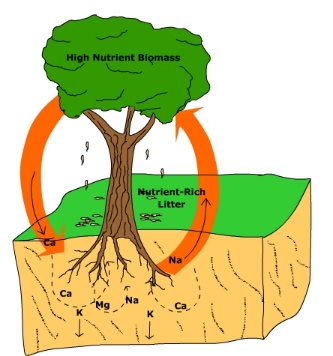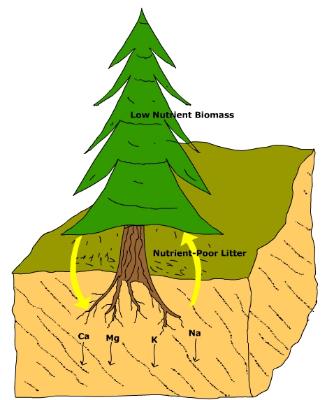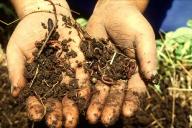OrganismsOrganism, both plant and animal, play an important role in the development and composition of soil. Organisms add organic matter, aid decomposition, weathering and nutrient cycling. The richness and diversity of soil organisms and plant life that grows on the surface is, of course, also tied to climate. Nutrient cyclingBiotic elements of the environment need life-sustaining nutrients that find their origin in the soil. Upon their death, organisms return these nutrients to the soil to be taken up again by other plants and animals. Hence there is a constant cycling of nutrients between organisms and soils. This cycling refreshes and maintains the nutrient status of soils. Without it, soluble nutrients would be leached from the soil, decreasing the soil's ability to support life.
The degree to which nutrients are cycled depends on the needs of the
organism occupying a particular place. For instance, broadleaf, deciduous trees like
oak and maple generally have high nutrient demand creating surface litter
rich in
nutrients when leaves die and fall to the forest floor. Decomposition of the litter
releases the nutrients back into the soil for the tree to take back up. Thus soils under these kinds of forests tend to
be high in soluble bases and nutrients.
Pine trees generally have low nutrient demands. The decaying litter
that falls to the forest floor is poor in nutrients. As a result, little cycling of
soluble nutrients like calcium, magnesium, sodium, and potassium occurs and
are thus leached creating an acidic soil environment. Organisms and weathering
Soil organisms also affect weathering. The decomposition of pine needles creates a weak acid that can strip soluble ions from the soil. Burrowing animals create passage ways through the soil to help aerate and allow water to infiltrate into it. Burrowing animals help translocate materials and fertilize the soil at depth. TimeAs time passes, the weathering processes continue to act on soil parent material to break it down and decompose it. Horizon development processes continue to differentiate layers in the soil profile by their physical and chemical properties. As a result, older more mature soils have well-developed sequence of horizons, though some may undergo so much weathering and leaching that visually distinct layers may be hard to see. This is a notable characteristic of oxisols. Some geological processes keep soils from developing by constantly altering the surface and thus not allowing parent material to weather over a significant period of time. For instance, erosion of hillsides constantly removes material thus impeding soil development. Along the channels of rivers, new sediment is frequently deposited as the river spills out onto its floodplain during floods. The constant addition of new material restarts the soil development process. Climate interacts with time during the soil development process. Soil development proceeds much more rapidly in warm and wet climates thus reaching a mature status sooner. In cold climates, weathering is impeded and soil development takes much longer. Video: Watch "The Five Factors of Soil Formation"
|
 Figure 11.12 Nutrient Cycling under broadleaf deciduous trees.
(After Oberlander & Muller, 1987) Click image to enlarge
Figure 11.12 Nutrient Cycling under broadleaf deciduous trees.
(After Oberlander & Muller, 1987) Click image to enlarge
 Figure 11.14Soil biota such as worms are important factor in soil development
(Source: A. Odoul. FAO#17449 Used with permission)
Figure 11.14Soil biota such as worms are important factor in soil development
(Source: A. Odoul. FAO#17449 Used with permission)